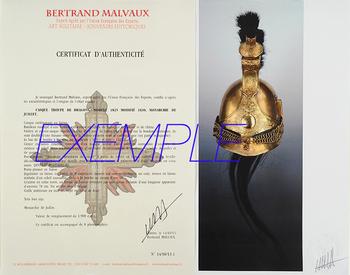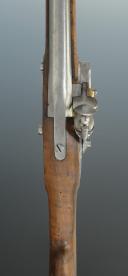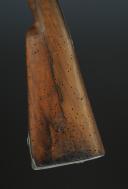
DRAGON RIFLE FROM THE TULLE MANUFACTURE, model year IX, First Empire. 20036
Sold out
DRAGOON RIFLE FROM THE TULLE MANUFACTORY, model year IX, First Empire. 20036
Barrel with five short flat sides, length 1.025 meters, length with the breech tail 1.08 meters, caliber 17.5 mm. Wooden stock. Cheekpiece on the stock stamped "EF ...(illegible)" and the rooster stamp with the inscription "PLD" (property of the state). Brass nose cap with steel spring attachment. Steel swivel attached by a spring placed in the center of the two bands and resting on the inner band. Brass side plate and trigger guard plate. Year IX lockplate signed "Mre Imple De Tulle". Steel buttplate. Steel ramrod.
All fittings and the lockplate are stamped with the "C" under coronet of Jean Cazamajou, born in 1784. He joined Versailles in 1800, returned on January 1, 1809 as 2nd controller, and left the Versailles manufactory for Tulle in September 1811.
Total length of the rifle 1.41 meters.
France.
First Empire.
Good condition, some woodworm holes mainly on the stock.
PAYMENT METHOD INFORMATION:
Firearms cannot be paid for via Paypal. This company refuses to trade any type of weapons, including collectible firearms that are freely circulating and possessable. Therefore, only checks, credit card payments by phone order, and IBAN transfers are accepted.
Warning requested by Google ranking service:
This firearm is an antique collectible weapon which cannot be used, it is inactive, and current cartridges are not compatible with this non-functional firearm.
The law of March 6, 2012 classifies weapons into 4 categories and regulates their acquisition and possession methods. Classification is, therefore, crucial. Decree No. 2013-700 of July 30, 2013 specifies the list of weapons for each category.
The presented weapon falls under category D2, free possession, and can be purchased without any restrictions as it is inactive.
NOTE:
END OF A LEGEND "PDL" IMPRINT ON NATIONAL GUARD WEAPONS
Extensive research has not yielded any citation confirming the existence of the motto "Pour le droit" (For the Law). So, what is it? What is the National Guard? The National Guard was created during the Revolution as a militia responsible for maintaining order and enforcing the law during turbulent times. It consisted of all citizens aged 20 to 60, listed and classified for service in reserve or active duty. Initially, National Guards were mainly bourgeois, required to equip themselves at their own expense, with cavalry members needing to provide their own horse. For the bourgeoisie, this role was a means of retaining a certain form of power, setting themselves apart from other citizens. National Guards were distributed across all municipalities and acted as a "Police" force under the command of an officer, the mayor, and the prefect. Under the Empire, the National Guard sometimes served as a reserve army and was mobilized for Napoleon's wars. After its dissolution by Charles X in 1827, it was revived by Louis Philippe in 1830, with a company established in each municipality. Infantry, artillery, cavalry, and firefighter companies were formed. The National Guard was reactivated to quell disturbances and maintain peace across France after the July Revolution.
Marking of weapons with "PDL" in 1831
At the end of 1830, the minister sought to organize the National Guards, leading to the collection and registration of weapons previously distributed during the July Revolution. A document from the Lyon city archives dated August 10, 1830, attests to this effort. In January 1831, a ministerial circular called for marking weapons received from the Ministry of War and thus belonging to the state. These arms were stamped with "PDL" indicating "Propriété De L'état" (Property of the State), as evidenced by a document from the Lyon prefecture archives dated January 20, 1831.
This mark was applied using a stamp circulating from village to village in each canton. The stamping process was carried out in the presence of assembled National Guards by mayors and commanders, with the stamp remaining the property of the canton's chief town. Subsequent stamping operations were possible. A report was drafted, signed by the Mayor, and sent to the prefecture.
The armament of the National Guards varied greatly, encompassing rifles, sabers, cartridge boxes, and other military equipment and uniforms, often of private manufacture and distinct from standard models. These items were acquired by the National Guards themselves or by municipalities. Additionally, there were standard issue weapons provided to municipalities by the Ministry of War.
Only the latter category of state-owned equipment was to be marked to verify state ownership and prevent armament dispersion. An excerpt from the January 1831 circular includes the printed instruction sheet accompanying the village stamp. The same circular also announced the creation, with the Interior Minister's approval, of an armament manual for National Guards.
In 1848, following the February revolution and the establishment of the Second Republic, a decree reactivated the National Guard in March. A newspaper from October 29, 1848, published the same measures as in 1831 (a law still in force) related to registering National Guards and their weapons. The "PDL" marking of state-owned weapons was reaffirmed. It was also stipulated that unauthorized alteration of National Guard weapons by private gunsmiths to percussion systems was prohibited to avoid a proliferation of available calibers.
Evolution of the PDL marking
Consultation of military archive records revealed further developments in this state identification mark.
PDL marking on edged weapons as well
Inspection of sabers or bayonets sometimes unveils this stamped mention.
Barrel with five short flat sides, length 1.025 meters, length with the breech tail 1.08 meters, caliber 17.5 mm. Wooden stock. Cheekpiece on the stock stamped "EF ...(illegible)" and the rooster stamp with the inscription "PLD" (property of the state). Brass nose cap with steel spring attachment. Steel swivel attached by a spring placed in the center of the two bands and resting on the inner band. Brass side plate and trigger guard plate. Year IX lockplate signed "Mre Imple De Tulle". Steel buttplate. Steel ramrod.
All fittings and the lockplate are stamped with the "C" under coronet of Jean Cazamajou, born in 1784. He joined Versailles in 1800, returned on January 1, 1809 as 2nd controller, and left the Versailles manufactory for Tulle in September 1811.
Total length of the rifle 1.41 meters.
France.
First Empire.
Good condition, some woodworm holes mainly on the stock.
PAYMENT METHOD INFORMATION:
Firearms cannot be paid for via Paypal. This company refuses to trade any type of weapons, including collectible firearms that are freely circulating and possessable. Therefore, only checks, credit card payments by phone order, and IBAN transfers are accepted.
Warning requested by Google ranking service:
This firearm is an antique collectible weapon which cannot be used, it is inactive, and current cartridges are not compatible with this non-functional firearm.
The law of March 6, 2012 classifies weapons into 4 categories and regulates their acquisition and possession methods. Classification is, therefore, crucial. Decree No. 2013-700 of July 30, 2013 specifies the list of weapons for each category.
The presented weapon falls under category D2, free possession, and can be purchased without any restrictions as it is inactive.
NOTE:
END OF A LEGEND "PDL" IMPRINT ON NATIONAL GUARD WEAPONS
Extensive research has not yielded any citation confirming the existence of the motto "Pour le droit" (For the Law). So, what is it? What is the National Guard? The National Guard was created during the Revolution as a militia responsible for maintaining order and enforcing the law during turbulent times. It consisted of all citizens aged 20 to 60, listed and classified for service in reserve or active duty. Initially, National Guards were mainly bourgeois, required to equip themselves at their own expense, with cavalry members needing to provide their own horse. For the bourgeoisie, this role was a means of retaining a certain form of power, setting themselves apart from other citizens. National Guards were distributed across all municipalities and acted as a "Police" force under the command of an officer, the mayor, and the prefect. Under the Empire, the National Guard sometimes served as a reserve army and was mobilized for Napoleon's wars. After its dissolution by Charles X in 1827, it was revived by Louis Philippe in 1830, with a company established in each municipality. Infantry, artillery, cavalry, and firefighter companies were formed. The National Guard was reactivated to quell disturbances and maintain peace across France after the July Revolution.
Marking of weapons with "PDL" in 1831
At the end of 1830, the minister sought to organize the National Guards, leading to the collection and registration of weapons previously distributed during the July Revolution. A document from the Lyon city archives dated August 10, 1830, attests to this effort. In January 1831, a ministerial circular called for marking weapons received from the Ministry of War and thus belonging to the state. These arms were stamped with "PDL" indicating "Propriété De L'état" (Property of the State), as evidenced by a document from the Lyon prefecture archives dated January 20, 1831.
This mark was applied using a stamp circulating from village to village in each canton. The stamping process was carried out in the presence of assembled National Guards by mayors and commanders, with the stamp remaining the property of the canton's chief town. Subsequent stamping operations were possible. A report was drafted, signed by the Mayor, and sent to the prefecture.
The armament of the National Guards varied greatly, encompassing rifles, sabers, cartridge boxes, and other military equipment and uniforms, often of private manufacture and distinct from standard models. These items were acquired by the National Guards themselves or by municipalities. Additionally, there were standard issue weapons provided to municipalities by the Ministry of War.
Only the latter category of state-owned equipment was to be marked to verify state ownership and prevent armament dispersion. An excerpt from the January 1831 circular includes the printed instruction sheet accompanying the village stamp. The same circular also announced the creation, with the Interior Minister's approval, of an armament manual for National Guards.
In 1848, following the February revolution and the establishment of the Second Republic, a decree reactivated the National Guard in March. A newspaper from October 29, 1848, published the same measures as in 1831 (a law still in force) related to registering National Guards and their weapons. The "PDL" marking of state-owned weapons was reaffirmed. It was also stipulated that unauthorized alteration of National Guard weapons by private gunsmiths to percussion systems was prohibited to avoid a proliferation of available calibers.
Evolution of the PDL marking
Consultation of military archive records revealed further developments in this state identification mark.
PDL marking on edged weapons as well
Inspection of sabers or bayonets sometimes unveils this stamped mention.
Reference :
20036

Next update Friday, april 4th at 1:30 PM
FOR ALL PURCHASES, PAYMENT IN MULTIPLE CHECKS POSSIBLE
bertrand.malvaux@wanadoo.fr 06 07 75 74 63
An authenticity certificate of the item including the description published on the site, the period, the sale price, accompanied by one or more color photographs is automatically provided for any item priced over 130 euros. Below this price, each certificate is charged 5 euros.
Only items sold by me are subject to an authenticity certificate, I do not provide any expert reports for items sold by third parties (colleagues or collectors).







